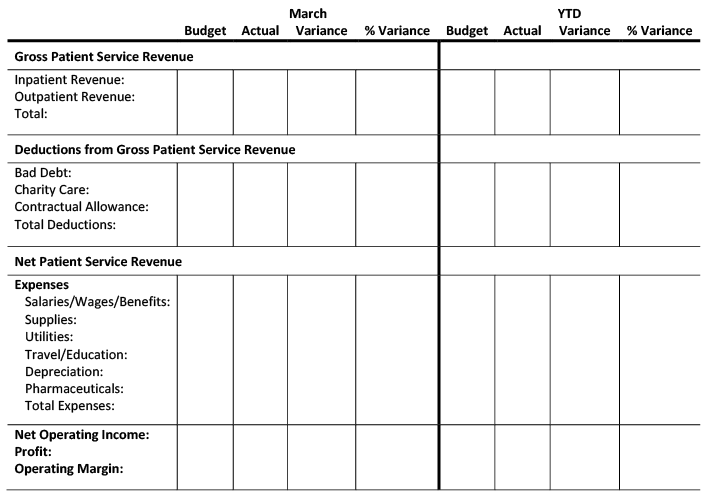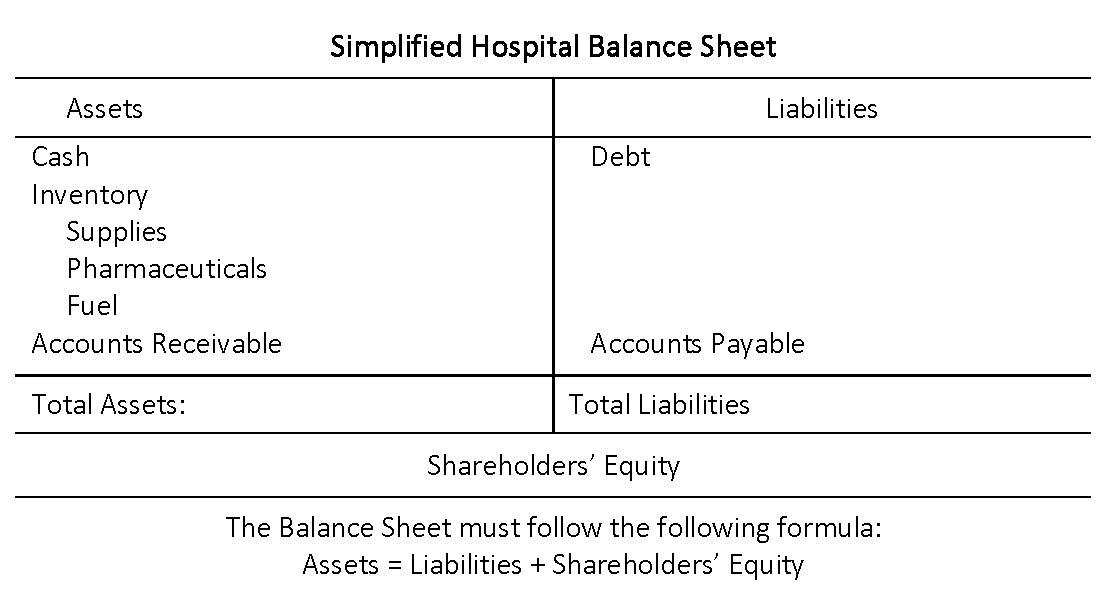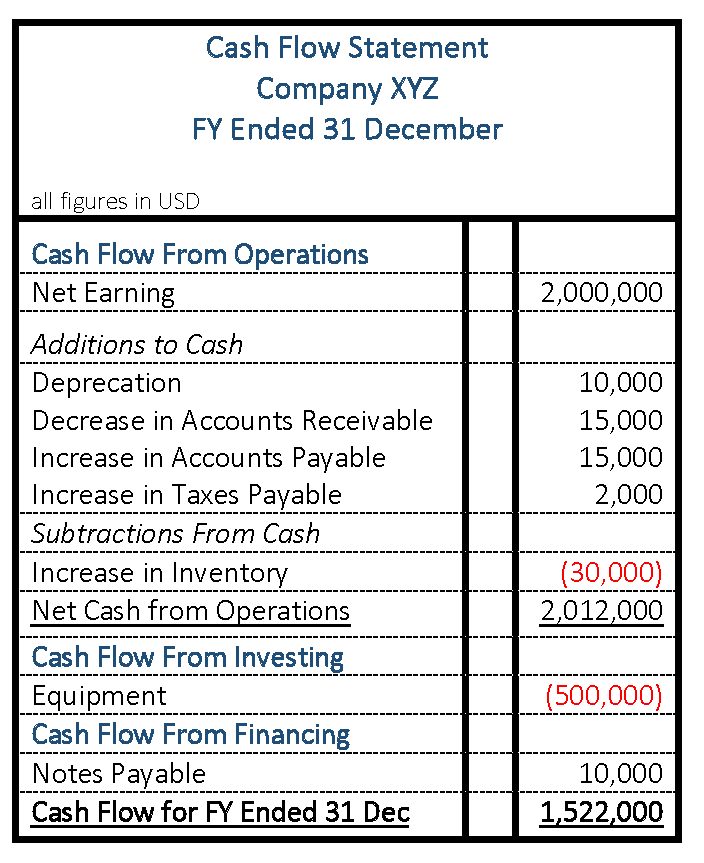
Essential Financial Reports
As a healthcare administrator, there are four* different financial reports that you will be maintaining and utilizing to report your fiscal accountability to your governing board and/or to your parent corporation (presuming that you are part of a "system").
[*The Statement of Owners’ Equity pertains only to for-profit entities.]

Definition of Income Statement
A financial statement that measures a company's financial performance over a specific accounting period. Financial performance is assessed by giving a summary of how the business incurs its revenues and expenses through both operating and non-operating* activities. It also shows the net profit or loss incurred over a specific accounting period, typically over a month, a quarter or a fiscal year.
Also known as the "profit and loss statement" or "statement of revenue and expense."
Source: Investopedia, June 2020
*Non-Operating Income consists of any revenue generated from sources other than patient services, e.g. investments, the sale of real estate or capital equipment, etc.

Definition of 'Balance Sheet'
A financial statement that summarizes a company's assets, liabilities and shareholders' equity at a specific point in time. These three balance sheet segments give investors an idea as to what the company owns and owes, as well as the amount invested by the shareholders. The balance sheet must follow the following formula: Assets = Liabilities + Shareholders' Equity
Source: Investopedia, June 2020
Essential Vocabulary:
An indicator of a company's financial performance which is calculated in the following EBITDA calculation:
EBITDA = Revenue - Expenses (excluding tax, interest, depreciation, and amortization)
EBITDA is essentially net income with interest, taxes, depreciation, and amortization added back to it, and can be used to analyze and compare profitability between companies and industries because it eliminates or neutralizes the effects of financing and accounting decisions.
Remember that the Balance Sheet, which we have already examined, shows the current “value” of the enterprise. That value, divided by the number of shares of ownership, determines the share/distribution of the equity that is controlled by each shareholder. The array of shareholders, typically, runs from largest to smallest, in descending order.
Statement of Shareholders’ Equity
[Name of the Enterprise]
As of [Date of this Statement]
Per-Share Value: $1,000.00

What is a Cash Flow Statement?
Complementing the balance sheet and income statement, the cash flow statement (CFS), a mandatory part of a company's financial reports since 1987, records the amounts of cash and cash equivalents entering and leaving a company. The CFS allows investors to understand how a company's operations are running, where its money is coming from, and how it is being spent. [Investopedia, February 2020]
Cash flow is determined by looking at three components by which cash enters and leaves a company: (1) core operations, (2) investing and (3) financing.
Operations
Measuring the cash inflows and outflows caused by core business operations, the operations component of cash flow reflects how much cash is generated from a company's products or services. Generally, changes made in cash, accounts receivable, depreciation, inventory and accounts payable are reflected in cash from operations.
Cash flow is calculated by making certain adjustments to net income by adding or subtracting differences in revenue, expenses and credit transactions (appearing on the balance sheet and income statement) resulting from transactions that occur from one period to the next. These adjustments are made because non-cash items are calculated into net income (income statement) and total assets and liabilities (balance sheet). So, because not all transactions involve actual cash transactions, many items have to be re-evaluated when calculating cash flow from operations.
For example, depreciation is not really a cash expense; it is an amount that is deducted from the total value of an asset that has previously been accounted for. That is why it is added back into net sales for calculating cash flow. The only time income from an asset is accounted for in CFS calculations is when the asset is actually sold.
Changes in accounts receivable on the balance sheet from one accounting period to the next must also be reflected in cash flow. If accounts receivable decreases, this implies that more cash has entered the company from customers paying off their credit accounts - the amount by which AR has decreased is then added to net sales. If accounts receivable increase from one accounting period to the next, the amount of the increase must be deducted from net sales because, although the amounts represented in AR are revenue, they are not cash.
An increase in inventory, on the other hand, signals that a company has spent more money to purchase more raw materials. If the inventory was paid with cash, the increase in the value of inventory is deducted from net sales. A decrease in inventory would be added to net sales. If inventory was purchased on credit, an increase in accounts payable would occur on the balance sheet, and the amount of the increase from one year to the other would be added to net sales.
The same logic holds true for taxes payable, salaries payable and prepaid insurance. If something has been paid off, then the difference in the value owed from one year to the next has to be subtracted from net income. If there is an amount that is still owed, then any differences will have to be added to net earnings.
Investing
Changes in equipment, assets or investments relate to cash from investing. Usually cash changes from investing are a "cash out" item, because cash is used to buy new equipment, buildings or short-term assets such as marketable securities. However, when a company divests of an asset, the transaction is considered "cash in" for calculating cash from investing.
Financing
Changes in debt, loans or dividends are accounted for in cash from financing. Changes in cash from financing are "cash in" when capital is raised, and they're "cash out" when dividends are paid. Thus, if a company issues a bond to the public, the company receives cash financing; however, when interest is paid to bondholders, the company is reducing its cash.
Analyzing an Example of a Cash Flow Statement
Let's analyze a cash flow statement in greater detail:

From this CFS, we can see that the cash flow for the FY (fiscal year) was $1,522,000. The bulk of the positive cash flow stems from cash earned from operations, which is a good sign for investors. It means that core operations are generating business and that there is enough money to buy new inventory. The purchasing of new equipment shows that the company has cash to invest in inventory for growth. Finally, the amount of cash available to the company should ease investors' minds regarding the notes payable, as cash is plentiful to cover that future loan expense.
Of course, not all cash flow statements look this healthy, or exhibit a positive cash flow. But a negative cash flow should not automatically raise a red flag without some further analysis. Sometimes, a negative cash flow is a result of a company's decision to expand its business at a certain point in time, which would be a good thing for the future. This is why analyzing changes in cash flow from one period to the next gives the investor a better idea of how the company is performing, and whether or not a company may be on the brink of bankruptcy or success.
Tying the CFS with the Balance Sheet and Income Statement
As we have already discussed, the cash flow statement is derived from the income statement and the balance sheet. Net earnings from the income statement is the figure from which the information on the CFS is deduced. As for the balance sheet, the net cash flow in the CFS from one year to the next should equal the increase or decrease of cash between the two consecutive balance sheets that apply to the period that the cash flow statement covers. (For example, if you are calculating a cash flow for the year 2020, the balance sheets from the years 2019 and 2020 should be used.) [Investopedia, February 2020]
Conclusion
A company can use a cash flow statement to predict future cash flow, which helps with matters of budgeting. For investors, the cash flow reflects a company's financial health: basically, the more cash available for business operations, the better. However, this is not a hard and fast rule. Sometimes a negative cash flow results from a company's growth strategy in the form of expanding its operations.
By adjusting earnings, revenues, assets and liabilities, the investor can get a very clear picture of what some people consider the most important aspect of a company: how much cash it generates and, particularly, how much of that cash stems from core operations, i.e. in the healthcare industry, how much cash is derived from patient services.
The concept of Depreciation
Generally accepted accounting principles (GAAP) and the American Hospital Association both provide for healthcare businesses to depreciate capital purchases. We will begin this discussion with the AHA definition of “capital” purchases. In the healthcare industry, any purchase which is equal to or in excess of $3,000 per individual item and which is used on more than one patient [both criteria must be met], qualifies for treatment as a capital purchase.
The Fixed Asset File
The vehicle through which depreciation and related issues are managed is known in the healthcare industry as the Fixed Asset File. This is an automated process which keeps track of key data elements:
Name and identification of each capital asset
Each month, there appears on the organization’s income statement a single figure that represents the total depreciation of all capital assets that are eligible for depreciation.
“To Expense a Purchase”
Any purchase that does not meet both criteria for the definition of “capital asset,” must be “expensed,” i.e. the organization must pay for it in full at the time of the purchase.
In order to manage capital assets, depreciation, useful life of assets, warranties and tax reporting, an organization establishes:
